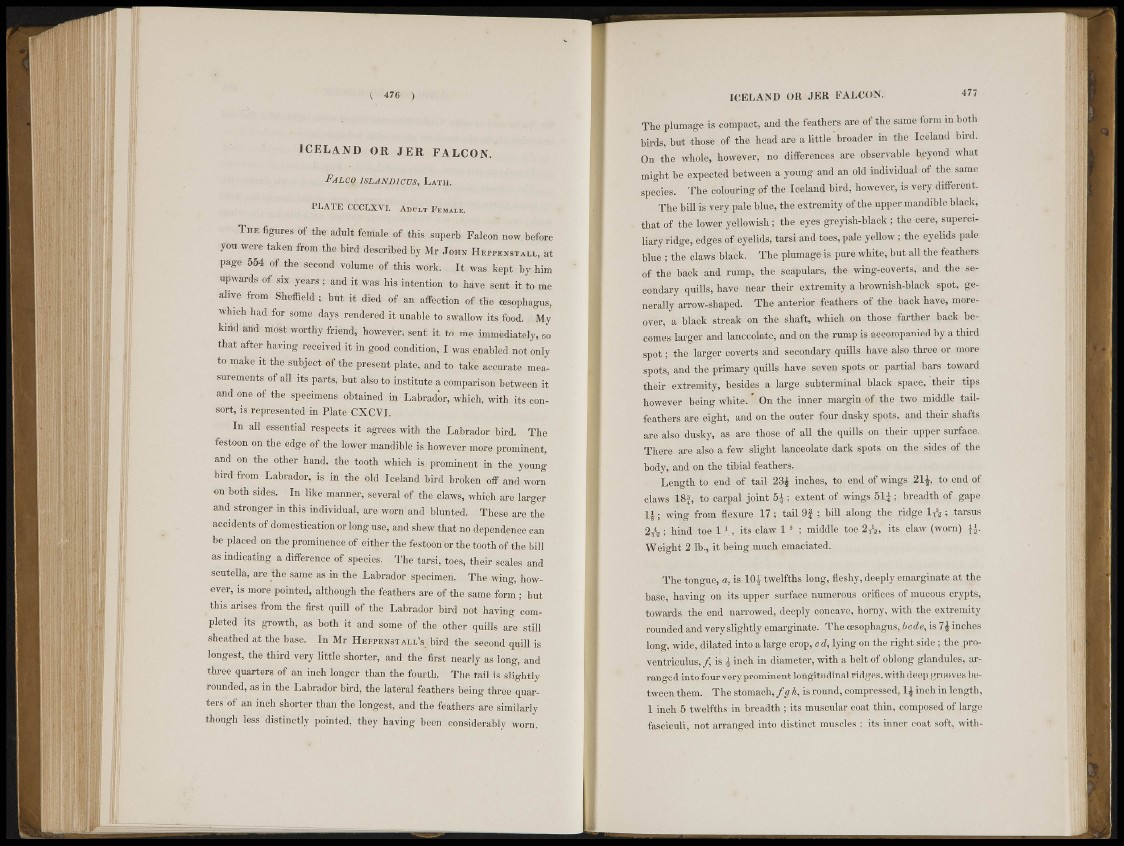
ip 43S*§
I C E L A N D OR JER l'ALCO.V
VALCQ 'x,,-'J"1*f|Mtii't mi'
, " ï â c i i v t J J ^ PEtoïÉ,
THE figure* .«f the adult feniale of this; superb Falcon now before
f m Wej* taken fttm, tte bWiloscribod l,.v Mr Joh.n H è b p e s : » ^ «
page &S4 of the sewnd vol,„„„ „(• this work. . I t was kept by him
ufwtods of six year.-! : and ft was! h » intention to l à » ; seat it to roe
a J i v e fr,>m ShefteJi; bnt it died of an affection of fBe oesophagus,
which had for some-days rendered i<t unable to swallow its food., My
kiiiil ¡«M mcist worthy friend, how.-veri sent" it t„ J n * immediately,,»
that after haying rtêeivedit in good condition, I w « enabled « f t only
to make it theSftbject of the present plate, and | | t a Ê accurate mea.
sûrement« of nil its part«, lmt also to institute a comparison between it
and one of the specimens obtained hi Labrador, which, with its consort,
is represented in Plate CXCVI.
In all essential rèspects, it agrees with the Labrador bird. The
festoon: on the edge of the lower mandible is however more prominent,
and on the. other hand, the tooth which,® prominent in the ¿ung
b i r t t o in Labrador; is in % dip Iceland bird broken off and worn
l m t h »»lesS* Ins like manner, several of %> claws, which arc larger
and stronger in this individual, are worn and Wunted, These ¡ire the
Meidents of domestication or long use, and shew that no dependence cm
be placed on the prominence/of either the festoon or the tooth of the bill
as indicating a difference § f species. The tarsi, toes, their: scales and
seuteila, are the same as in the Labrador spwimnri. The wing, however,
is: more pointed, although the- feathers are of the same form : but
this arises from the first quill of the Labrador bird not having completed
its growth, as both it and some of the other quills are still
•sheathed at the bas«. In Mr UKrrEXsTAi.i.'s.bml the second quill is
longest, the third very little shorter, and the first nearly^ long, and
three quarters of an inch longer than the fourth. The tail is slightly
rounded, as in tile Labrador bird, the lateral feathers being three quart
e t «f: an inch shorter than the longest, and the feathers are similarly
though less distinctly pointed, they having been considerably worn.
ICELAND OR JER FALCON. 477
The ¡plumage i * compact, and the feathers me of the same form in both
birds, but those of. the head are a little'broader in the Iceland bird.
On the whole, however, no differences are observable 'beyond what
might bo expected between a young and an old individual of the same
spefflfe The colouring of the Iceland bird, howeM^ is very different.
The Wilis very pale blue, the extremity of the upper mandible black,
that, of the lower- yellowish; the eyes greyish-black; the .cere, superciliary
ridge, edges of eyelids, tarsi and toes, pale yellow; the eyelids pale
blue ; the daws black. The plumage is pure white, but all the feathers
of the back and rump, the scapulars, the wing-covcrts, and the secondary
quills, haw near their extremity a brownish-black spot, generally
arrow-shaped. The anterior feathers of the back have, moreover,
a black streak 011 the shaft, which on those, farther back becomes
larger and lanceolate, and on the rump is accompanied by a third
spot; the larger coverts and secondary quills have also three or more
spots, and the primary quills have sewn spots or partial bars toward
their extremity, besides a large subterminal black space, their tips
however being white..'1 On the inner margin of the -two middle tail-
;feathers: are fight, and: on the outer four dusky spots, and their shafts
are also dusky, as are those of all the quills on their upper surface.
There are also a few slight lanceolate dark spots on the sides of the
body, and on the tibial feathers.
Length to end of tail 23$ inches, to end of wings 21|, to end of
claws 181« to carpal joint ; extent of wings 51.1,; breadth of gape
1|; wing from flexure 17 ; tail 9 | ; bill along the ridge It's; .tarsus
2A; kind toe 1 \, its claw 1 ® 5 middle toe 2^, ' , its claw (worn) jgj
Weight 2 lb., it being much emaciated.
The tongue, a, is lOf twelfths long, fleshy, deeply emarginate at the
base, having on its upper surface numerous orifices of mucous crypts,
towards the end narrowed, deeply concave, horny, with the extremity
rounded and very slightly emarginate. The oesophagus, bode, is 7 | inches
long, wide, dilated into a large crop, c d, lying on the right side; the provcntriculus./,
is j inch in diameter, with a belt of oblong glandules, arranged
into four very prominent longitudinal ridges, with deep grooves between
them. The stomach,./"» A, is round, compressed, 1£ inch in length,
X inch 5 twelfths in breadth ; its muscular coat thin, composed of large
fasciculi, not arranged into distinct muscles ; its inner coat soft, with